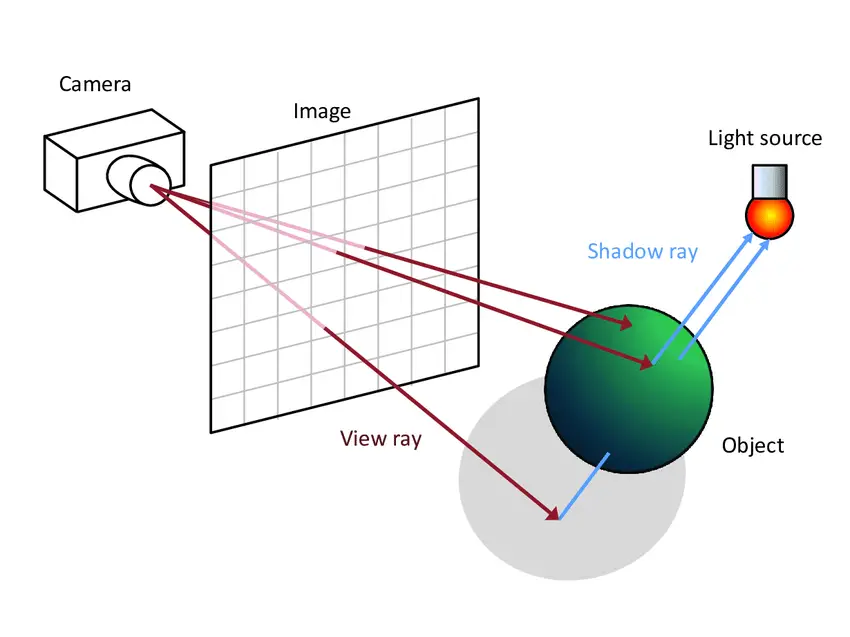Most people have heard about ray tracing technology, but what exactly is ray tracing in computer graphics in video games and other computer visual applications?
This guide will break it down in simple language for you to understand.
Ray Tracing Explained

In layman's terms, ray tracing renders computer graphics to simulate the physical behavior of light bouncing off objects. The more realistic it can simulate reflection, highlights, motion blur, chromatic aberrations, light bounce, shadow ...etc means more realistic lighting effects.
Ray tracing generates an image by tracing the path of light as pixels in an image plane. A typical use of ray-tracing would be the creation of three-dimensional models for computer graphics or design and games in real-time computing.
In many ways, it significantly improve graphics quality as computer hardware advances, and the technology will allow developers to create better experiences with less effort.
Ray Tracing On Paper Explained

Rays are drawn from the origin, or eyepoint, to each point on the object being rendered. The color at the point where a ray intersects an object is determined by applying the material properties of that object to the ray.
For example, a red material would cause a ray to reflect all the way back to the eyepoint, while a white material would cause the ray to be absorbed.
History Of Ray Tracing Technology

Ray tracing has been used for film special effects since the 1970s, but it has become increasingly popular in recent years with advances in CPU power and graphics technology.
Before ray tracing was introduced, rasterization was the technique to transform a vector (curve based) image to a rasterized (pixel based) image. It basically approximates how light behaves, but it's not very customizable compared to what we have today.

In games, rasterization technology requires the game to command the GPU to create the 3D scenes with polygons, and then rasterize all of it into individual pixels, then let the shader process them with lighting, color and texture information.
Rasterization is fast, and provides good frame rate. However, the downside of rasterization is the limitation on how accurately the light travels and bounces off objects within a particular scene, and it doesn't provide visual depth.
This is why ray tracing technology is developed.
Ray Tracing In Video Games & Movies

Ray tracing technology is mostly used in video games and movies to bring life alike experiences to the players and audience.

The top two graphics card companies, Nvidia and AMD are the two top competitors dominating the market and they release new graphics cards every year to meet the demand of gamers, 3D renders, and movie makers.
Here is the difference between games with and without ray tracing
Ray Tracing ON VS OFF

Ray Tracing Pros
- Very realistic visual rendering - almost photorealistic
- Great story telling for movies and games
- Immersive experience for VR applications
- Just amazing
Ray Tracing Cons
- Intensive hardware requirement on CPU, GPU and memory
- Lower FPS if system meets minimum requirement
- May not worth the gain if the game performance drops
FAQ
Does Ray Tracing Technology Affect FPS?
Ray tracing technology does lower FPS to some extend based on the graphics card capability and the applications. In order to support ray tracing to give the game the most realistic ray tracing look and maintain high FPS, the CPU and GPU must support it.
Users can tweak the graphics setting, but at the end of the day, the computing power of the hardware matters the most. This is why users upgrade computer parts to run the latest graphics-intensive applications.
While ray tracing increases the visual quality if the game is well designed to benefit from it, but sometimes it's not worth the gain if the overall gaming FPS experience is poor and the visual isn't that much different.
Which Graphics Card Support Ray Tracing

Currently these graphics cards support ray tracing. These are top of the line products in 2022
- NVIDIA GTX 3080
- NVIDIA GeForce RTX 3090
- NVIDIA GTX 3070
- NVIDIA GeForce RTX 2080 Super
- AMD 6800 XT
